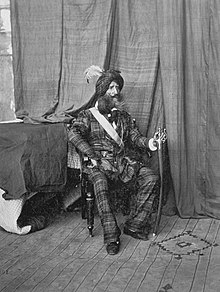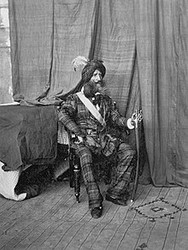Colonel Alexander Gardener
Posted by Charles MacGregor on Oct 14th 2018
Originally Published December 2010. Written for The Celtic Croft by Charles MacGregor of MacGregor Historic Games.
Colonel Alexander Gardener
I admit I may be stretching the "Celtic" connection pretty thin for this month, but it is about the son of a Scottish immigrant, and he is such an interesting character I couldn't resist Another American-born adventurer, Josiah Harlan is believed to have been the real life inspiration for Rudyard Kipling's story (and the Sean Connory/Michael Caine movie) "The Man who would be King," but I can't help but suspect Alexander Gardner was also an inspiration. I first into ran a fictionalized description of Alexander Gardner in the novel Flashman and the Mountain of Light by George MacDonald Fraser. Here was the description that Fraser's main character provided of him:
"I noticed a an extraordinary figure lounging in an embrasure above the gate, swigging from an enormous tankard and barking orders at a party of Guardsmen drilling with the light guns on the wall. He was a real Pathan mercenary, with iron moustaches and a nose like a hatchet - but he was dressed from top to toe, puggaree (turban), robe an pyjamys, in the red tartan of the 79th Highlanders! Well I've seen a Madagascar n---er in a Black Watch kilt, but this beat all. Stranger still, he carried a great metal collar in one hand, and each time before he drank he would clamp it around his throat, almost as though he expected the liquor to leak out through is Adam's apple."
The only known photo of him, taken in his 80's and eventually published in his memoir, shows Gardner to be just as imposing as his fictional alter-ego. -Still wearing tartan from head to toe -including a turban with a feather plume. The description of the metal collar is due to one of the 14 wounds it is claimed that he sustained over his colorful career. It is said that due to a neck wound he could no longer swallow properly and that collar provided assistance, or support when eating and drinking.
Gardner was born in 1785 in the state of Wisconsin to a Scottish father and an Anglo-Spanish mother. About 1809 he traveled to Ireland. When he returned to America in 1812, he found that his father had died and so left for Russia where his brother was working, and never came back to the U.S. After the death of his brother he tried to secure a post in the Russian Army, but was turned down and so spent the next 13 years wandering through Central Asia. One writer describes his life during that time as "that of an adventurous freebooter, ready to fight for anybody." In Afghanistan, 1823 Habib Ullah Khan, the nephew of Dost Mohammed Khan was fighting his uncle for the throne of Kabul, and Habib recruited Gardner to his cause as the commander of 180 horsemen. Gardner married a woman captured in an attack on a pilgrim caravan, and Habib granted him a small hilltop fort as his home. Unfortunately when Habib was finally defeated in 1826 Gardner's wife and child were murdered by the forces of Dost Mohammed Khan.
For several years after the death of his family his story becomes rather unclear and fragmented including what some authors have called some improbable episodes. Eventually becomes a Commandant of Artillery, and in 1830 he swore allegiance to the Maharajah Ranjit Singh, the "Lion of the Punjab." There, he was one of between 30 and 100 Western soldiers serving in Ranjit's army and was eventually granted the rank of colonel. The Maharajah had some interesting expectations of his western mercenaries and Gardner tells of one point where Ranjit Singh insists that they build him steamboat. It ends up sounding like a scene from Fraser's tongue-in-cheek novel mentioned above. They were given 40,000 Rupees to begin the project, 15,000 of which are promptly side-tracked by corrupt officials at court. Not having access to "modern" engineering and metal working they did not have the ability build a steam engine, but that didn't stop the project...
"I read up all I could about paddle-boat building and succeeded in turning out a wondrous sort of two-decked barge, with paddle wheels to be worked by hand? Ranjit Singh clapped his hands, as was his wont, in ecstasy with the boat, in the sides of which I had made port holes which bristled with swivel guns. This boat was launched on the Ravi (river), but with the utmost efforts of the exhausted wheel turners would not go more than ten yards or so up the stream. However Ranjit Singh was delighted. I had built fore and aft cabins, and he filled them with nautch girls (dancing girls)."
Unfortunately Gardner's story is not all gallant adventure and humor. His biographers seem to have ignored some of the brutal episodes that others remembered, including Gardner cutting off the noses of certain offenders as ordered by the Maharajah. Thus he may not be as noble a character as some would like to read about, but his life certainly is one of those that is as strange and interesting as any fiction tale. Unlike many similar adventurers, his end was not a violent one, but rather he eventually retired to Cashmere and died peacefully in 1877.
His memoirs are in the public domain and can be downloaded for free through the Internet Archive.
A more recent biography The Tartan Turban: In Search of Alexander Gardner has come out since the original publication of this article and takes a critical look at his memoirs and information provided by previous biographers.
One last thing — Ever wonder why Colonel is pronounced with an R?

